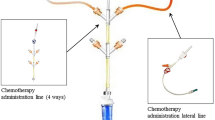Abstract
Purpose
The aim of this pilot study was to evaluate surface contamination by platinum drugs in the environment of patients in ICUs and wards treated by hyperthermic intraperitoneal chemotherapy (HIPEC).
Methods
The monitoring included 12 HIPEC treatments from four hospitals during the following 3 days after perfusion. A total of 33 urine and 33 drainage fluids from HIPEC patients and 160 wipe samples from several surfaces (urine/drainage bags, floors, gloves) were taken during the study period.
Results
In urine, the highest platinum concentrations were measured on the first day after perfusion. Median platinum concentrations were 1260 ng/ml for patients after cisplatin perfusion and 11,000 ng/ml for oxaliplatin treatment. Concentrations decreased until day three to 413 ng/ml cisplatin and 529 ng/ml oxaliplatin, respectively. In drainage liquids, platinum concentrations were generally lower. Platinum concentrations from surfaces of bags and floors ranged from 0.01 to 439 pg/cm2 (median: urine bag 2.77 pg/cm2, drainage bag 0.22 pg/cm2, floor left 0.14 pg/cm2, floor right 0.24 pg/cm2), with the highest contamination found on the outer surface of the urine bags. Samples from nurses’ protective gloves ranged between 0.03 and 12 pg/cm2 (median: 0.2 pg/cm2).
Conclusions
High platinum-drug concentrations in urine and drainage liquids are the main source of contamination. Therefore, safe handling of these liquids is the best way to avoid cross-contamination on surfaces in wards and ICUs. Our results show that it is possible to take care of HIPEC patients without high contaminations during the first 3 days.

Similar content being viewed by others
References
Becker K, Schulz C, Kaus S, Seiwert M, Seifert B (2003) German Environmental Survey 1998 (GerES III): environmental pollutants in the urine of the German population. Int J Hyg Environ Health 206:15–24
Bryant J, Clegg AJ, Sidhu MK, Brodin H, Royle P, Davidson P (2005) Systematic review of the Sugarbaker procedure for pseudomyxoma peritonei. Br J Surg 92:153–158
Ensslin AS, Pethran A, Schierl R, Fruhmann G (1994) Urinary platinum in hospital personnel occupationally exposed to platinum-containing antineoplastic drugs. Int Arch Occup Environ Health 65:339–342
Esquivel J (2009) Technology of hyperthermic intraperitoneal chemotherapy in the United States, Europe, China, Japan, and Korea. Cancer J 15:249–254
Ferron G, Simon L, Guyon F, Glehen O, Goere D et al (2015) Professional risks when carrying out cytoreductive surgery for peritoneal malignancy with hyperthermic intraperitoneal chemotherapy (HIPEC): a French multicentric survey. Eur J Surg Oncol 41:1361–1367
German Guideline Program in Oncology (2014) Evidence based guideline for colorectal cancer, long version 1.0. AWMF registration number: 021-007OL. German Cancer Society, German Cancer Aid, AWMF. http://leitlinienprogramm-onkologie.de/Leitlinien.7.0.html
Gonzalez-Bayon L, Gonzalez-Moreno S, Ortega-Perez G (2006) Safety considerations for operating room personnel during hyperthermic intraoperative intraperitoneal chemotherapy perfusion. Eur J Surg Oncol 32:619–624
International Agency for Research on Cancer (IARC) (1987) Monographs on the evaluation of carcinogenic risks to humans. In: Overall evaluations of carcinogenicity: an updating of IARC monographs, vol 1–42, Suppl 7. Lyon, France
Konate A, Poupon J, Villa A, Garnier R, Hasni-Pichard H et al (2011) Evaluation of environmental contamination by platinum and exposure risks for healthcare workers during a heated intraperitoneal perioperative chemotherapy (HIPEC) procedure. J Surg Oncol 103:6–9
Kopp B, Schierl R, Nowak D (2013) Evaluation of working practices and surface contamination with antineoplastic drugs in outpatient oncology health care settings. Int Arch Occup Environ Health 86:47–55
Kromhout H, Hoek F, Uitterhoeve R, Huijbers R, Overmars RF et al (2000) Postulating a dermal pathway for exposure to antineoplastic drugs among hospital workers. Applying a conceptual model to the results of three workplace surveys. Ann Occup Hyg 44:551–560
Naslund Andreasson S, Anundi H, Thoren SB, Ehrsson H, Mahteme H (2010) Is platinum present in blood and urine from treatment givers during hyperthermic intraperitoneal chemotherapy? J Oncol 2010:649719
Schierl R, Bohlandt A, Nowak D (2009) Guidance values for surface monitoring of antineoplastic drugs in German pharmacies. Ann Occup Hyg 53:703–711
Schierl R, Novotna J, Piso P, Böhlandt A, Nowak D (2012) Low surface contamination by cis/oxaliplatin during hyperthermic intraperitoneal chemotherapy (HIPEC). Eur J Surg Oncol 38:88–94
Villa AF, El Balkhi S, Aboura R, Sageot H, Hasni-Pichard H et al (2015) Evaluation of oxaliplatin exposure of healthcare workers during heated intraperitoneal perioperative chemotherapy (HIPEC). Ind Health 53:28–37
Acknowledgments
We thank Mr. Christopher Plechinger and Nadja Blumschein (Kardialgut Germany) for great support. Thanks also to all physicians, surgeons, perfusionists and nurses of the participating hospitals. The platinum analyses were performed by Stefan Gröbmair, Gisela Gümperlein and Isak Qoroli. We want to thank Trish van der Beke (Chicago, Illinois) for improving our English wording. Data published here are part of the doctoral thesis of KS.
Author information
Authors and Affiliations
Corresponding author
Ethics declarations
Conflict of interest
All authors declare that there are no conflict of interests.
Rights and permissions
About this article
Cite this article
Schenk, KE., Schierl, R., Angele, M. et al. Cisplatin and oxaliplatin surface contamination in intensive care units (ICUs) and hospital wards during attendance of HIPEC patients. Int Arch Occup Environ Health 89, 991–996 (2016). https://doi.org/10.1007/s00420-016-1137-3
Received:
Accepted:
Published:
Issue Date:
DOI: https://doi.org/10.1007/s00420-016-1137-3




